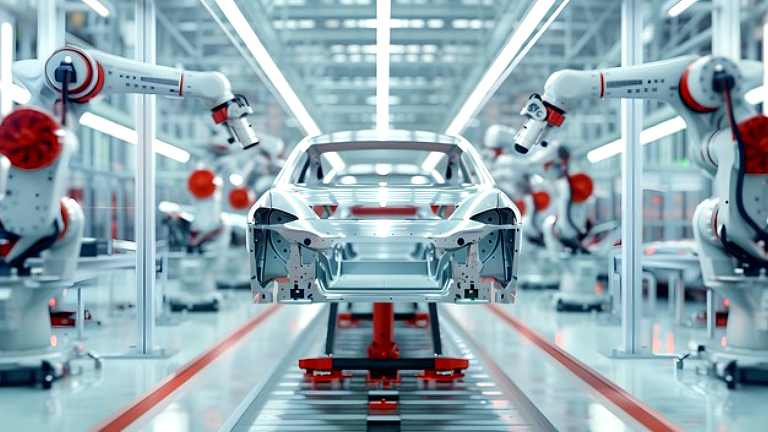AI leads the multifunctional robot revolution across industries

Xiaomi Auto recently stunned the entire automotive industry when it delivered 300,000 SU7 vehicles in just 15 months. These numbers attest a staggering production rate for new-energy vehicles (NEVs), and set a new record in the ramp-up of production capacity of NEV manufacturers. Supporting this “flywheel effect” is a smart manufacturing system that rolls a car off the assembly line every 76 seconds. To achieve this level of productivity, over 700 robots work in synergy, achieving a 100% automation rate across more than 200 critical processes. This revolution in efficiency is due to the dramatic transformation of industrial robots enabled by artificial intelligence (AI). Beyond smart manufacturing, AI’s widespread impact extends to vast and expansive industries such as healthcare and logistics.
Machine Vision: The "eagle eyes" of industrial manufacturing
To appreciate the impact of AI in automotive manufacturing, let’s consider the die-casting workshop in an automotive factory. Here, a massive 9,100-ton die-casting machine forms aluminum sheets into car body components in a single process. An X-ray intelligent inspection system based on deep learning ensures that each die-cast part is flawless. Like a seasoned master craftsman, it identifies micron-level defects through X-ray images, with a level of accuracy that eclipses manual inspection dozens of times over.
This next-generation machine vision technology addresses limitations in previous vision systems that relied on preset rules and struggled with complex scenarios. Cutting-edge solutions combine three major breakthroughs: 3D visual perception, point cloud processing, and large-scale vision models. High-precision RGB-D cameras achieve millimeter-level positioning under strong light or reflective conditions. Dynamic target recognition algorithms handle chaotically stacked workpieces. And large-scale vision models accurately identify internal defects in X-ray images with limited samples. This technology enables quality inspection systems to achieve 99.9% accuracy while simplifying the once time-consuming quality inspection process in automotive manufacturing into an instantaneous task.
Smart Decision-Making: From mechanical execution to autonomous optimization
While vision systems provide robots with “eyes,” AI decision-making engines endow them with a “brain.” An advanced automotive assembly factory forms a complete smart closed loop in which Automated Guided Vehicles (AGVs) transport components, robots perform precise assembly, and a central system optimizes the rhythm of production in real time. This collaboration relies on three key technological pillars. Firstly, a dynamic production scheduling platform integrates the status of equipment and uses quality data for visualized control. Secondly, a mixed-flow production system supports flexible switching between multiple vehicle models, enabling a single production line to meet many different manufacturing needs. And thirdly, the most revolutionary application of large-scale industrial models, which enables “registration-free grasping of general objects,” means that robots can quickly adapt to handling new parts, significantly reducing production line changeover time. This zero-shot learning (ZSL) capability is the core value of future fully automated “lights-out factories.”
Embodied Intelligence: The “eye-brain-hand” system for cross-domain collaboration
Emerging embodied AI technology helps traditional industrial robots break free from reliance on structured environments. The breakthrough “eye-brain-hand” integrated platform leverages multi-modal perception technology, enabling robots to understand their own forms using only visual data. Autonomous planning systems can instantly output 6D models of objects, while dexterous operations can control door installation gaps to within ±0.3mm.
This closed-loop model has moved beyond the factory and is rapidly revolutionizing a growing number of industries. In busy logistics warehouses, 3D vision acts as a “smart eye,” precisely guiding robots to adeptly sort packages of varying shapes and sizes with methodical efficiency. In life-critical operating rooms, vision-guided robotic arms achieve ultra-high precision operations to within ±0.02mm, akin to the results of a skilled surgeon. Clearly, we have entered the era of general-purpose robots.

Overcoming Challenges in AI and Robotics Development
According to Statista market forecast data, the global AI robotics market is projected to grow from US$17 billion in 2024 to US$30 billion by 2027. Driven by the continuous improvement in the availability of facilitative technologies, it is expected to rise to US$82.5 billion by 2032.
AI empowers the next generation of robots with the ability to adapt to dynamic environments, interact with humans, and perform complex tasks. Of course, progress is never without its challenges. In terms of data security boundaries, the training of large-scale industrial models relies on massive amounts of production data. Finding a balance between protecting intellectual property and promoting technology sharing has become a burning issue. As for safety in human-robot collaboration, despite the capability of micro-vision to identify human presence and initiate an emergency stop within 0.5 seconds, more reliable safety mechanisms are needed in high-speed scenarios.
To address these challenges, Avnet has developed the IOTCONNECT™ platform based on Amazon Web Services (AWS). The platform utilizes a low-level abstraction interface to simplify AWS service integration, making large-scale development and deployment of interconnected solutions, such as autonomous robots, effortless.
In addition, Avnet offers a range of image and depth sensor products tailored for automotive, industrial, and commercial applications. These products deliver outstanding performance in complex lighting conditions, with high dynamic range and excellent low-light capabilities, to ensure stable system operation in various environments. This provides robust hardware and software support to tackle the challenges of the AI robotics era.
The multifunctional robot revolution is unstoppable – and so is Avnet’s commitment to making sure its customers are leading the way for their respective industries.

